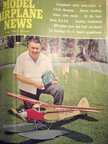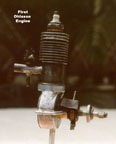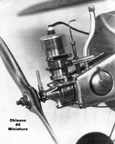June, 1968

Model Airplane News Cover for June, 1968
Irwin Ohlsson
Click to Enlarge
Here is what the blurb about the cover has to say:
"... Our man on the cover may not stir the new generation of modelers, but he certainly did stir the troops back in the late 1930s with his famous "Ohlsson 23" engine. This si a roundabout way to introduce Irwin Ohlsson who is a year or two older since the advent of his fine mediium sized spark ignition system. It added a new dimension to free flight and new times and records became a way of life. Find some old MAN's and look at the exciting Ohlsson ads to get the whole story ..."
About Iwin Ohlsson
Irwin “Irv” Ohlsson was fascinated with airplanes deom an early age. At age 18, Irv had already built and flown a number of rubber band powered aircraft and had won 11 major contest trophies. One was for a record-setting flight of 1 hour and 3 minutes reaching an altitude of 4300 feet and flying over 30 miles. In 1934, Irv Ohlsson took a 30 cc gas engine designed for model boat use and fitted it to an airplane model of his own design. It had an 8-foot wingspan, weighed 10 pounds and had a 20” propeller; his entry stayed aloft for an hour and 6 minutes—a record that stood for many years. A pilot in an airplane flying nearby reported sighting Irv’s plane at 5500 feet in altitude.
In 1934, The Los Angeles Herald Examiner was looking for a small model aircraft they could use as an incentive for their delivery boys to boost circulation. Having gained a name for himself with his record-setting flights, Irv Ohlsson was asked to build the first prototype. To keep costs down, it was to be powered by a compressed-air engine that burned a solid fuel stick to produce the gas to drive the 5-cylinder radial powerplant. It flew well but the heat generated would often cause the airplane to catch fire after landing, so the project was abandoned. Later, however, he had an idea of how to build a gas powered engine that would be small enough for the project. He and a friendproduced two very small engines with .12 cubic inch displacement. By this time, however, there was a different editor at the newspaper and the model incentive project had been abandoned, but Irv Ohlsson was on his way to a career in designing model airplane engines.
After graduation, Irv went to work for Douglas Aircraft. but left to open a model shop in Los Angeles. He had come up with a good design for an engine; it sold for $16.50, which was about a week’s pay for the average worker at the time. Many boys now recall saving their every penny for a long time to buy that engine for their model airplane. The Ohlsson Mini was known as the Gold Seal and had a displacement of .56 cubic inches and produced about 5 pounds of thrust with a 14” prop at 7000 RPM. In 1937 he came up with the Pacemaker model airplane design (shown on the cover). The kit and engine together sold for $25.00
By 1941 Irv Ohlsson had teamed up with Harry Rice, and the firm of Ohlsson & Rice were producing a ".19, the famous ".23" and a ".60" that were highly popular, combining reliability, ease of maintenance, simplicity of operation and long life. During the Second World War all O&R facilities were turned over to military production. By that time, they had produced about 75,000 engines. As soon as the war was over, O & R got back into production. Even with a shortage of needed materials and machines somewhat worn out by 3-shift a day wartime production use, they jumped back into a market that had a seemingly endless demand for their products. Modelers were hungry to get back into flying, and O & R took advantage of the market by buying the machinery needed to meet the huge demand. By the end of 1947 their production had risen to almost a thousand engines per working day.
When glow plug engines started to become popular in 1947, O & R were ready with their own designs. One of the problems with glow engines was the availability of the proper fuel, so they began manufacturing their own brand of fuel for both glow and ignition engines. They also started making propellers, metal-bodied model racecars and a series of O & R glow plugs. In 1949 they released their new "29", and quickly followed it with the "Redhead 33". At this point they were at the pinnacle of their career with the largest and wealthiest company in the hobby industry.
Rushing so many new products to market at once, however, had some serious ill effects on the quality of the engines. The new designs started to show some flaws that caused many engines to be returned to the factory for repair. The high number of returned engines caused financial stress that eventually led to the breakup of the partnership of Ohlsson and Rice, but not before they had produced well over a half million engines.



Irwin Ohlsson's Creations
Middle: Irv flying Pacemaker in the 1930s
Click to Enlarge

Click to go back and select another cover.
Counter for the Entire Site (not just this page..)
Home | About Lindy | Last Week's Reviews | Upcoming Events | 1940s Collecibles
The Guide - Establishments - Travel - Accessories
Music | Links | Photo Gallery | Extras | Contact